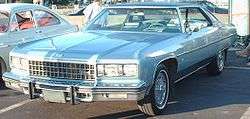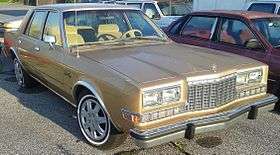Downsize (automobile)
Downsizing in the automobile industry is the practice of redesigning a vehicle to retain the interior volume, and often the nameplate and styling of a larger car to a smaller, more efficient platform. It was common in the 1970s following the 1973 oil crisis.
General Motors was among the first to announce a downsize strategy for the whole company as a response to demand for smaller more efficient cars.[1] An alternative strategy was to simply rebadge or mildly restyle smaller vehicles, as nameplates such as the Ford LTD and Plymouth Fury were applied to smaller platforms.
The term engine downsizing is used when the car itself remains the same size but the engine is reduced, with the aim of making the vehicle more efficient.
Research and progress
The University of Bath published research carried out by its Powertrain and Vehicle Research Centre which demonstrated that it is possible to reduce engine capacity by 60% and still achieve the torque curve of a modern, large-capacity naturally-aspirated engine, while encompassing the attributes necessary to employ such a concept in premium vehicles.[2]
Examples
General Motors
From 1977 to 1982, in order, General Motors would physically downsize its full-size, intermediate, compact, and subcompact vehicle product lines in the process of vehicle redesigns. For 1977, all five GM car divisions ( Buick, Cadillac, Chevrolet, Oldsmobile, and Pontiac) saw the downsizing of their full-size vehicle lines, with an average length reduction of 12 inches and 750-800 pounds in weight (with over 1000 pounds in some examples). While producing a smaller exterior footprint than the GM intermediate product lines, the full-size cars would see similar interior dimensions as their predecessors. For 1978, the GM intermediate product line (based on the GM A platform) became true mid-size cars with similar size reductions.
For 1980, to allow for downsizing in its compact segment, the cars of the GM X platform were replaced on a front-wheel drive platform, allowing for increased interior dimensions. In 1982, the GM J platform, while similar in size to its GM H platform predecessor, would also adopt front-wheel drive to increase its interior space.
In 1985, GM would undergo its second (and last) major downsizing; the full-size cars of Buick, Oldsmobile, and Pontiac (except station wagons) were discontinued along with most of the Cadillac full-size line, with the nameplates all shifted to front-wheel drive mid-size vehicles. By the end of the 1980s, nearly all cars produced by GM would be front-wheel drive. At the end of the 1996 model year, the B-platform was discontinued, with all future rear-drive cars sourced from Holden of GM Australia.
Size comparison between 76 and 77 Caprice
| 1976 Caprice | 1977 Caprice | |
|---|---|---|
| Wheelbase | 121.5 in (3,086 mm) | 116.0 in (2,946 mm) |
| Overall Length | 222.9 in (5,662 mm) | 212.1 in (5,387 mm) |
| Width | 79.5 in (2,019 mm) | 75.5 in (1,918 mm) |
| Height | 53.7 in (1,364 mm) | 55.3 in (1,405 mm) |
| Front Headroom | 38.9 in (988 mm) | 39.0 in (991 mm) |
| Front Legroom | 42.5 in (1,080 mm) | 42.2 in (1,072 mm) |
| Front Hip Room | 59.3 in (1,506 mm) | 55.0 in (1,397 mm) |
| Front Shoulder Room | 63.8 in (1,621 mm) | 61.1 in (1,552 mm) |
| Rear Headroom | 38.0 in (965 mm) | 38.2 in (970 mm) |
| Rear Legroom–ins. | 38.8 in (986 mm) | 39.5 in (1,003 mm) |
| Rear Hip Room | 59.7 in (1,516 mm) | 55.7 in (1,415 mm) |
| Rear Shoulder Room | 63.8 in (1,621 mm) | 61.1 in (1,552 mm) |
| Luggage Capacity | 18.9 cu ft (535 L) | 20.9 cu ft (592 L) |
 1976 Chevrolet Caprice |
 1978 Chevrolet Caprice |
Chrysler
Nearly concurrent with the 1973 gas crisis, Chrysler introduced larger and heavier 1974 full-size models for Plymouth, Dodge, and Chrysler. In contrast to Ford and General Motors, the company's full-size car sales would never recover from the gas crisis and other factors would nearly push the company into bankruptcy. Chrysler was forced to concentrate its development on fuel-efficient compact cars.
For the 1979 model year, the success found by GM and the upcoming introduction of smaller full-size cars by Ford necessitated a response from Chrysler. As a replacement for the C-platform redesigned in 1974, the company introduced the R-body vehicles. Unable to develop a new design from the ground up, Chrysler was relegated to reworking its existing 1962-1978 intermediate platform. The R-series wore comparable dimensions as its Ford and General Motors competition. By the end of the 1981 model year, poor sales of all four R-body cars (Newport/New Yorker/Gran Fury/St. Regis) outside of fleet markets forced its discontinuation.
After 1980, downsizing would take a much more radical form at Chrysler. As a replacement for the Dodge Aspen/Plymouth Volare, the company introduced the Dodge Aries/Plymouth Reliant. Known as the K-cars, they were the first front-wheel drive cars developed entirely within the company. In spite of their small exterior footprint (a wheelbase 1.2" longer than the Omni/Horizon hatchback), the K-cars offered 6-passenger seating; they were classified as mid-size cars by the EPA. With the introduction of the K-Cars as midsize cars, Chrysler took a new approach at the full-size market, largely for fleet buyers. While technically a mid-size car, the M-body cars (Dodge Diplomat) were an update of the original 1976-1980 Aspen/Volare, which were marketed as "compacts"; discontinued after 1989, they were the last rear-wheel drive Chrysler sedans for 16 years. The midsize M-series of the 1980s with 112.7" wheelbase and 205" length was actually similar to size to the intermediate class 1967 AMC Rebel and 1964-77 Chevrolet Chevelle.
In the 1980s era of downsizing, Chrysler explored alternatives for large family vehicles. Declining sales along with lack of development funds led Chrysler to not include station wagons as part of the 1979 redesign of its full-size cars. After 1982, Chrysler sold a single station wagon, the compact K-Car. In 1984, the company introduced its first minivans; although largely based on the K-Car, the Plymouth Voyager and Dodge Caravan approached full-size wagons in terms of passenger and cargo carrying capabilities. After 1988, the K-car wagons disappeared, leaving no passenger car wagons in the company portfolio until the new 2005 Dodge Magnum.
|
Ford
Alongside Chrysler, Ford introduced its own downsized full-size car platform in 1979. Like GM's downsizing, the Ford and Mercury models of Panther platform were over 15 inches (380 mm) shorter and 800 pounds (360 kg) lighter; the Ford LTD was left lighter and shorter than the "intermediate" LTD II. However, Ford retained the same amount of interior room from the 1978 model. The Lincoln Continental became the last full-size nameplate to undergo downsizing; formerly the largest mass-produced car in North America, it too became produced on the Panther platform for the 1980 model year.
In 1983, Ford used a strategy of badge engineering to further downsize certain models while avoiding the cost of developing new vehicle platforms. In an effort to move its full-size cars upmarket, the Panther-platform cars retained their top-of the line models (LTD Crown Victoria, Grand Marquis, and the Town Car) while the lower-trim models were moved onto the mid-size Fox platform. The Continental became a successor to the 1977-1980 Versailles, while the LTD replaced the Granada. As the Mercury Cougar shifted back to its traditional role of a personal-luxury car, the Marquis replaced the unpopular Cougar sedan and station wagon models.
During the mid-1980s, as front-wheel drive was adopted in mid-size cars, Ford replaced most Fox platform variants with those from the D186 platform; this was introduced by the 1986 Ford Taurus and Mercury Sable. With this introduction, Ford's era of downsizing had stopped. The Taurus was essentially the same size as the LTD it replaced; the only significant downsizing that happened was the discontinuation of the V8 engine seen (as an option) in the LTD/Marquis. Today, the current Taurus now serves as Ford's Crown Victoria replacement, although it has gained well over 1,000 pounds (450 kg) in 25 years of production. Conversely, after their 2011 discontinuation, the Town Car and Grand Marquis were left without any direct replacements (the latter marking the end of the Mercury brand).
References
- ↑ Chevrolet – the Story of a Global Brand Archived October 22, 2007, at the Wayback Machine.
- ↑ Lewis, A.G.J. (1 April 2014). "Ultra Boost for Economy: extending the limits of extreme engine downsizing". SAE International Journal of Engines. Retrieved 8 July 2014.

